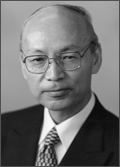206th ECS Meeting | Honolulu, HI | Oct. 18, 2004

Innovative Challenges of Bioelectronics

Innovative Challenges of Bioelectronics
Professor Masuo Aizawa was introduced by Junichi Tanahashi, the President of ECSJ for 2004. After a stellar academic career at the Tokyo Institute of Technology in the field of bioelectronics and biosensors, Aizawa joined the administrative ranks there and is currently serving as president of the University. Professor Aizawa’s lecture, entitled “Innovative Challenges of Bioelectronics,” began with a discussion of the world changing to a globalized knowledge society. He identified an emerging new frontier melding biotechnology, nanotechnology, and information technology in which electrochemistry could play a key role.
Bioelectronics is one field that has grown out of this synergy. Professor Aizawa then painted a historical backdrop of this field. He showed how Galvani’s discovery of bioelectric events in a frog’s leg spawned the disciplines of electrophysiology and molecular biology. Scientists subsequently began to be interested in how information was processed in the brain. These studies have focused on both inter-cellular (sensory, nerve, immune) and intra-cellular (signal transduction, gene expression) phenomena. The concept of “molecular information networks” took on new significance not only from a fundamental perspective but also in terms of practical applications (e.g., artificial intelligence). It is interesting that such studies have transcended the “hard sciences” of biology and physiology into disciplines such as psychology and biomedical engineering.
Professor Aizawa presented the notion of bioelectronics as providing a bridge for the gap between the bio-information world and the electronics information world in which molecules and electrons/photons could be regarded as the “transduction elements.” As an example of the role that bioelectronics could play in this regard, he described electrically-controlled gene expression in a living cell. Specifically, the activation of nerve growth factor (NGF) gene expression by electric stimulation was described.
The final part of the lecture dealt with challenges for the future in bioelectronics. The first category involves evolving therapeutics including cell-based devices for tissue prosthesis and on-demand production of insulin. Drug delivery is another important application of bioelectronics. The second category seeks cell-based biodevice alternatives for animal testing—obviously important from both ethical and cost-cutting viewpoints. Thus the living cell substitutes for an animal to probe the effect of chemical and drug-induced stress. Other aspects in this category include bioanalytical approaches for diagnostics based on patch clamp, optical, or electrode array methodologies.
The last challenge identified was the scale progression from macrolevel biosensors to the “ultimate” biodevices based on DNA chips or bio-MEMS and micro-TAS. This bionanotechnology interface encompasses challenging problems such as single molecule detection and on-the-fly monitoring of dynamic molecular interactions within living organisms.
All in all, this plenary lecture kept a packed audience in the hall thoroughly engaged in envisioning the exciting possibilities with bioelectronics in the biodevices and bioanalysis areas. Perhaps, the notion of popping a diagnostic biosensor pill that instantly reports back on everything going on inside our body real-time via a “reading” device may not turn out to be science fiction after all.
